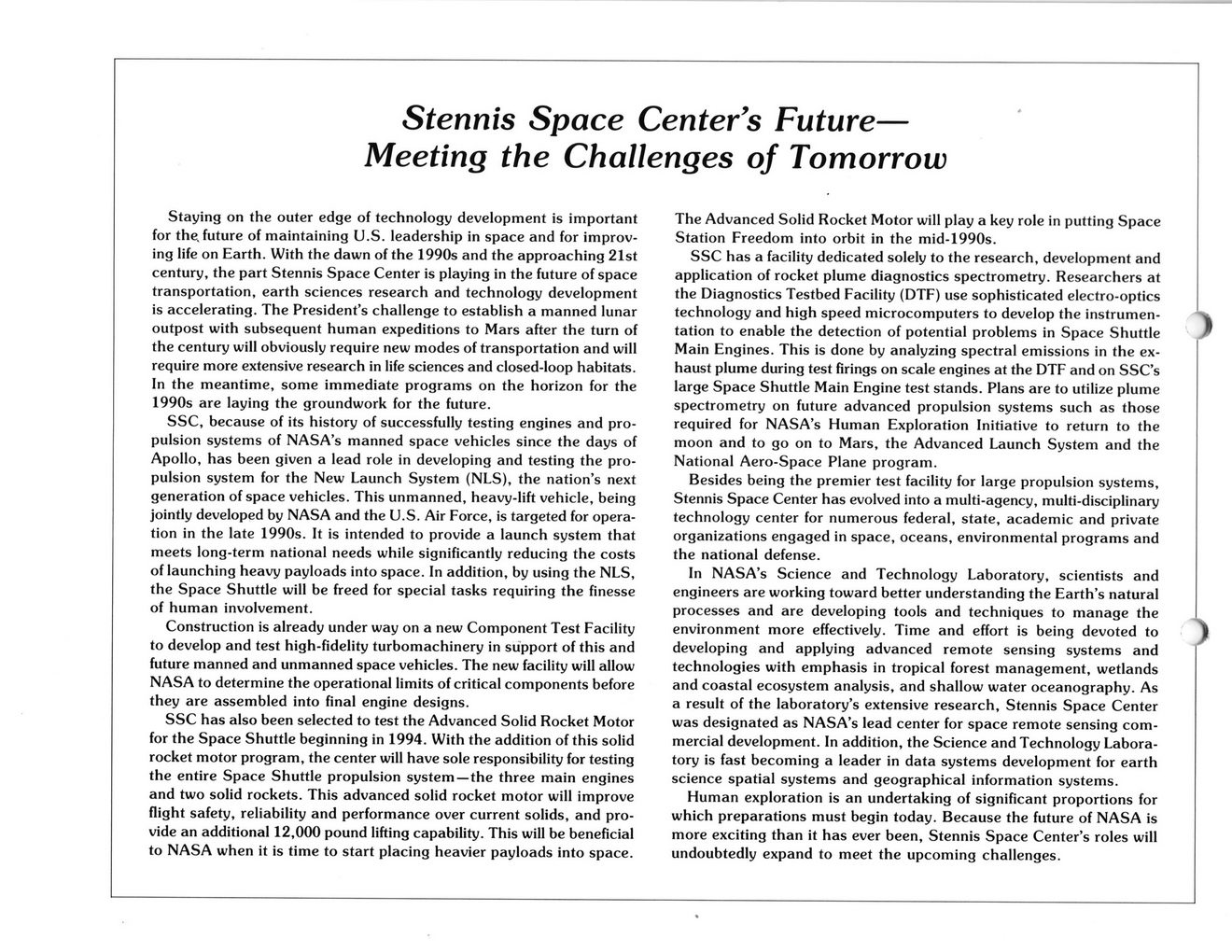This text was obtained via automated optical character recognition.
It has not been edited and may therefore contain several errors.
Stennis Space Center's Future— Meeting the Challenges of Tomorrow Staying on the outer edge of technology development is important for the, future of maintaining U.S. leadership in space and for improving life on Earth. With the dawn of the 1990s and the approaching 21st century, the part Stennis Space Center is playing in the future of space transportation, earth sciences research and technology development is accelerating. The President’s challenge to establish a manned lunar outpost with subsequent human expeditions to Mars after the turn of the century will obviously require new modes of transportation and will require more extensive research in life sciences and closed-loop habitats. In the meantime, some immediate programs on the horizon for the 1990s are laying the groundwork for the future. SSC, because of its history of successfully testing engines and propulsion systems of NASA’s manned space vehicles since the days of Apollo, has been given a lead role in developing and testing the propulsion system for the New Launch System (NLS), the nation’s next generation of space vehicles. This unmanned, heavy-lift vehicle, being jointly developed by NASA and the U.S. Air Force, is targeted for operation in the late 1990s. It is intended to provide a launch system that meets long-term national needs while significantly reducing the costs of launching heavy payloads into space. In addition, by using the NLS, the Space Shuttle will be freed for special tasks requiring the finesse of human involvement. Construction is already under way on a new Component Test Facility to develop and test high-fidelity turbomachinery in support of this and future manned and unmanned space vehicles. The new facility will allow NASA to determine the operational limits of critical components before they are assembled into final engine designs. SSC has also been selected to test the Advanced Solid Rocket Motor for the Space Shuttle beginning in 1994. With the addition of this solid rocket motor program, the center will have sole responsibility for testing the entire Space Shuttle propulsion system—the three main engines and two solid rockets. This advanced solid rocket motor will improve flight safety, reliability and performance over current solids, and provide an additional 12,000 pound lifting capability. This will be beneficial to NASA when it is time to start placing heavier payloads into space. The Advanced Solid Rocket Motor will play a key role in putting Space Station Freedom into orbit in the mid-1990s. SSC has a facility dedicated solely to the research, development and application of rocket plume diagnostics spectrometry. Researchers at the Diagnostics Testbed Facility (DTF) use sophisticated electro-optics technology and high speed microcomputers to develop the instrumentation to enable the detection of potential problems in Space Shuttle Main Engines. This is done by analyzing spectral emissions in the exhaust plume during test firings on scale engines at the DTF and on SSC’s large Space Shuttle Main Engine test stands. Plans are to utilize plume spectrometry on future advanced propulsion systems such as those required for NASA’s Human Exploration Initiative to return to the moon and to go on to Mars, the Advanced Launch System and the National Aero-Space Plane program. Besides being the premier test facility for large propulsion systems, Stennis Space Center has evolved into a multi-agency, multi-disciplinary technology center for numerous federal, state, academic and private organizations engaged in space, oceans, environmental programs and the national defense. In NASA’s Science and Technology Laboratory, scientists and engineers are working toward better understanding the Earth’s natural processes and are developing tools and techniques to manage the environment more effectively. Time and effort is being devoted to developing and applying advanced remote sensing systems and technologies with emphasis in tropical forest management, wetlands and coastal ecosystem analysis, and shallow water oceanography. As a result of the laboratory’s extensive research, Stennis Space Center was designated as NASA’s lead center for space remote sensing commercial development. In addition, the Science and Technology Laboratory is fast becoming a leader in data systems development for earth science spatial systems and geographical information systems. Human exploration is an undertaking of significant proportions for which preparations must begin today. Because the future of NASA is more exciting than it has ever been, Stennis Space Center’s roles will undoubtedly expand to meet the upcoming challenges.

NASA Document (060)